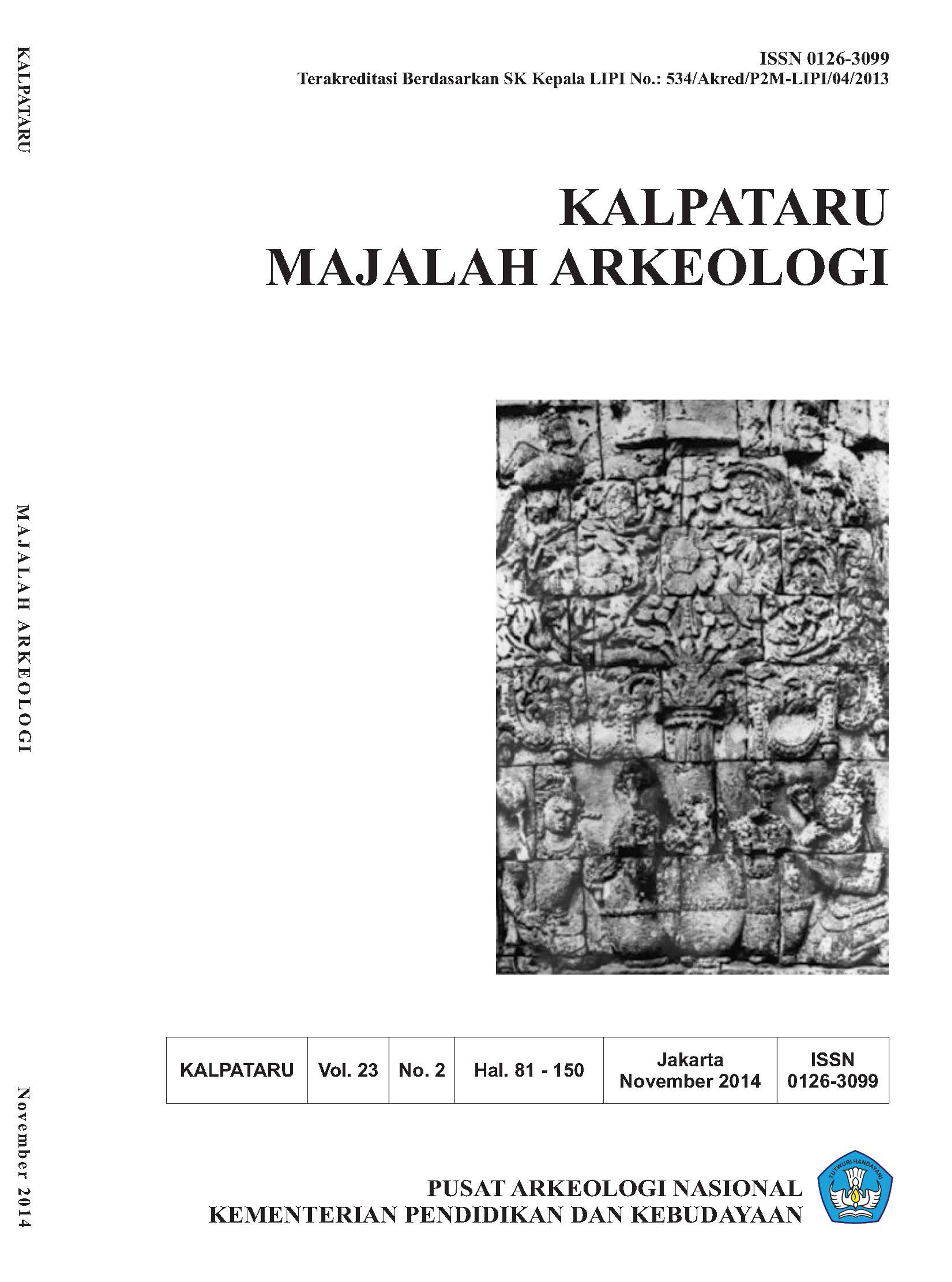INVASI ŚRIWIJAYA KE BHUMIJAWA: PENGARUH AGAMA BUDDHA MAHAYANA DAN GAYA SENI NALANDA DI KOMPLEKS PERCANDIAN BATUJAYA
Main Article Content
Abstract
This paper discusses the influence of Śrīvijaya invasion to Bhūmijāwa (Tārumanāgara) in the late 7th Century C.E. The focus of discussion is the influence of Mahāyāna Buddhism and the art style of Nālandā in the temple complex of Batujaya, Karawang, West Java. The results of the archaeological research conducted at Batujaya site area during the period of 1985-2006 has yielded some new evidence on the spread of Mahāyāna Buddhism and the art style of Nālandā in that area.
Paper ini membahas pengaruh invasi Śrīwijaya ke Bhūmijāwa (Tārumanāgara) pada akhir abad ke-7 M. Fokus pembahasan adalah pengaruh Agama Buddha Mahāyāna dan gaya seni Nālandā di kompleks percandian Batujaya, Karawang, Jawa Barat. Hasil penelitian di Batujaya selama periode 1985-2006 telah menghasilkan beberapa bukti baru penyebaran Agama Buddha Mahāyāna dan gaya seni Nālandā di Kompleks percandian Batujaya.
Article Details
This work is licensed under CC BY-NC-SA 4.0
Authors whose articles are getting published must agree with the following rules:
- Publication rights for all contents published in Kalpataru Journal (printed and online versions) belong to The Board of Directors with acknowledgment of the authors (morale right still belongs to the author)
- Legal formal regulation for digital access to electronic journal follows the rule of Creative Commons license Commons Attribution-NonCommercial-ShareAlike (CC BY-NC-SA), which means Kalpataru Journal is a non-commercial publication, holds the right to keep, format, and manage the articles into the database, maintain, and publish articles
- Published articles both in printed and online versions are accessible for all purposes of education, research, and library archives. The board of directors is not responsible for any violations of the copyrights outside those purposes.
References
Acharya, P.K. 1979. An Encyclopedia of Hindu Architecture. New Delhi: Oriental Books Reprint (Manasara Series, vol. VII).
Atja. 1968. Carita Parahijangan: Naskah Titilar Karuhun Urang Sunda Abad ka-16. Bandung: Yayasan Kebudayan Nusalarang.
Ayatrohaedi. 2005. Sundakala: Cuplikan Sejarah Sunda Berdasarkan Naskah- naskah Panitia Wangsakerta Cirebon. Jakarta: Pustaka Jaya.
Bagchi, P.C. 1934. “A Note on the Pratītya Samutpāda Sūtra”, Epigraphia Indica, 21: 199-203.
Boechari. 1986. “New Investigation on the Kedukan Bukit Inscription”, dalam: Untuk Bapak Guru Jakarta: Pusat Penelitian Arkeologi Nasional, pp. 33-56.
Casparis, J.G. de 1956. Prasasti Indonesia: II.
Selected Inscriptions from the 7th to the 9th Century A.D. Bandung: Masa Baru.
---------. 1975. Indonesian Palaeography: A History of Writings from the Beginning to c. A.D. 1500. Leiden: E.j. Brill.
Chakravarti, N.P. 1934. “The inscribed bricks of Nālandā”, Epigraphia Indica, 21: 199 dst.
Cœdès, G. 1918. “Le royaume de Çrīvijaya”, Bulletin del’École Françaised’Extrême- Orient, XVIII. pp 1-36
---------. 1930. “Les inscriptions malaisesss de Çrīvijaya”, Bulletin de l’École Françaised’Extrême-Orient, XXXI: 29-
Cœdès, G. dan L.-Ch. Damais. 1989. Kadātuan Śrīwijaya: Penelitian tentang Sriwjaya. Jakarta: Departemen Pendidikan dan Kebudayaan. Damais, L.-C.
---------. 1952. “Liste de principales inscriptions datées de l’Indonésie”, Bulletin del’École Française d’Extrême-Orient, XLVI: 1-105.
Danasasmita, Saleh, dkk. 1983-1984. Rintisan Penelusuran Sejarah Masa Silam Sejarah Jawa Barat. 4 jilid. Bandung: Pemerintah Provinsi Daerah Tingkat I Jawa Barat.
Djafar, Hasan. 1991. “Prasasti-prasasti dari Masa Kerajaan Sunda”. Seminar Sejarah dan Sastra Pakuan Pajajaran. Bogor, 11-13 November 1991.
---------. 2010. Kompleks Percandian Batujaya: Rekonstruksi Sejarah Kebudayaan Daerah Pantai Utara Jawa Barat. Bandung: Kiblat Buku Utama/École française d’Extrême-Orient/Pusat Penelitian dan Pengembangan Arkeologi Nasional/ Koninklijk Instituut voor Taal-, Land- en Volkenkunde.
---------. 2012. “Pentarikhan Inskripsi-inskripsi Tak Bertarikh dari Kompleks Percandian Agama Buddha di Batujaya”, dalam: Nik Hassan Shuhaemi Nik Abdul Rahhman dkk. Penyunting), Isu-isu Pentarikhan Tapak Warisan & Artifak Budaya Alam Melayu, hal. 112-137. Bangi: Institut Alam dan Tamadun Melayu, Universiti Kebangsaan Malaysia,
Ghosh, A. 1938. “The brick inscriptions of Nālandā”, Ephigraphia Indica, 24: 20 dst.
Kempers, A.J. Bernet. 1933. “The Bronzes of Nālandā and the Hindu-Javanese Art”, Bijdragen tot deTaal-, Land- en Volkenkunde , 90: 1-88.
Kern, H. 1913. “Inscriptie van Kota Kapur (eiland Bangka; 608 Çāka)”, Bijdragen tot de Taal-, Land- en Volkenkunde van Nederlandsch-Indië, 67: 393-400.
---------. 1917. “Inscriptie van Kota Kapur (eiland Bangka; 608 Çāka)”, Verspreide Geschriften, VII: 205-214.
Krishnan, Gauri Parimoo (Editor) 2008. On the Nālandā Trail: Buddhism in India, Asia, Cina & Southeast Asia, Singapore: Asian Civilizations Museum.
Krom, N.J. 1926. Hindoe-Javaansche Geschiedenis. ‘s-Gravenhage: Martinus Nijhoff. (Tweede herziene drukt: 1931).
Liebert, Gösta 1976. Iconographic Dictionary of the Indian Religions. Hinduism – Buddhism – Jainism. Leiden: E.J. Brill. [Studies in South Asian Culture, Vol. V. Edited by J.E. van Lohuizen-de Leeuw]
Li Yung-shi 1957. A Record of the Buddhist Countries by Fa-hsien. Translated from the Chinese by Li Yung-hsi. Peking: The Chinese Buddhist Association.
Manguin, P.-Y. and Agustijanto Indradjaja 2011. “The Batujaya Site: New Evidence of Early Indian Influence in West Java”, in: Pierre-Yves Manguin, A. Mani and Geoff Wasde (Eds.), Early Interactions between South and Southeast Asia: Reflections on Cross- Cultural Exchange. Singapore: Institute of Southeast Asian Studies/New Delhi: Manohar. Pp. 113-136.
Moens, J.L. 1937. “Çrīvijaya, Yāva en Kaṭaha”, Tijdschrift voor Taal-, Land- en Volken- kunde, 77: 317-487.
---------. 1940. “Was Pūṇawarman van Tārūmā een Saura?”, Tijdschrift voor Taal-, Land- en Volken- kunde, 80: 78-109.
Poerbatjaraka, R.M.Ng. 1952. Riwajat Indonesia, I. Djakarta: Pembangunan.
Santiko, Hariani. 2000. “Perkembangan awal Agama-agama di Indonesia”, dalam: Endang Sri Hardiati (Ed.), Katalog Pameran Fajar Nusantara. Jakarta: Museum Nasional, hal. 41-48.
---------. 2001. “The Religion of King Pūṇawarman of Tārumanāgara”, dalam: Marijke J. Klokke dan K.R. van Kooij (eds.), Fruits of Inspiration: Studies in Honour of Prof. J.G. de Casparis. Groningen: Egbert Forsten, hal. 423- 434.
Sastri, Hirananda. 1942. “Nālandā and its Epigraphic material”, Memoir of Archaeological Survey of India, 66: 75 dst.
Schlegel, G.1899. “Notes XIII: Tan-tan or Dan-dan, Don-din?”, T’oung Pao, 10: 459-463.
Srivastava, K.M. 1993. “The Sites and Stucco Figurines of Nālandā”, Arts of Asia, 23(4): 91-99.
Suleiman, Satyawati. 1980. “The History and Art of Śrīwijaya”, dalam: M.C. Subhadradis Diskul
---------. (Ed.), 1980. The Art of Śrīwijaya (Paris: UNESCO), pp. 9-19.
Vogel, J.Ph. 1925. “The Earliest Sanskrit Inscriptions of Java”, Publicaties van den Oud- heidkundigen Dienst in Nederlandsch-Indië, I: 15-35, Plate 27-35.
Wolters, O.W. 1979. “Studying on Srivijaya”, JMBRAS, 52(2), pp. 1-32.

